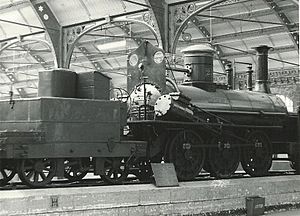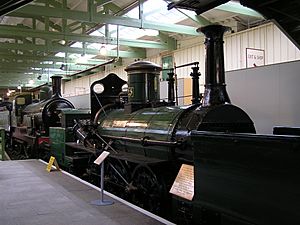Derwent (locomotive) facts for kids
Derwent is a very old and special steam locomotive. It was built way back in 1845. This amazing train has six wheels for power, which is why it's called an 0-6-0 type. It was made by William and Alfred Kitching for the Stockton and Darlington Railway. Today, you can see Derwent at the Darlington Railway Centre and Museum, also known as Head of Steam. It's a real piece of history!
Contents
Meet Derwent: A Historic Steam Train
Derwent is a famous steam train from the early days of railways. It was built in 1845. This makes it one of the oldest surviving steam locomotives. It shows us how trains looked and worked a long time ago.
How Derwent Was Built
The famous engineer Timothy Hackworth designed Derwent. It was built by William and Alfred Kitching in Darlington, England. They finished building it in 1845. Derwent was similar to other trains they built. These included Leader and Trader.
Derwent's Special Features
Derwent had its steam cylinders on the outside. These were at the back of the boiler. It also had six wheels, each about four feet wide. All six wheels were connected. This helped the train pull heavy loads.
Derwent's Adventures and Retirement
Derwent worked hard for the Stockton and Darlington Railway. It pulled trains for many years. In 1869, it stopped working on the main railway lines. It was then sold to a company called Pease & Partners.
Working in the Coal Mines
Derwent was used on their coal mine lines. It even helped build the Waskerley Reservoir in County Durham. This shows how useful old trains could be.
A Star at Celebrations
Derwent also took part in special events. In 1881, it was at the Stephenson Centenary celebrations in Newcastle. This event honored George Stephenson, a railway pioneer. It also appeared at Queen Victoria's Diamond Jubilee in 1887.
Saving Derwent: A Journey to Preservation
In 1898, the North Eastern Railway (NER) decided to save Derwent. They wanted to keep it for future generations. This was a great step for railway history.
Running Again for a Special Day
Derwent was carefully fixed up. In 1925, it even ran under its own steam! This was for the Railway Centenary procession. It reached a speed of 12 miles per hour. This was quite fast for such an old train.
Finding a Home in a Museum
For many years, Derwent was displayed at Bank Top station. It stood next to another famous train, Locomotion No. 1. In the 1960s, it was restored to look like it did when it was new.
Today, Derwent is on display at the Darlington Railway Centre and Museum. This museum is also known as Head of Steam. It is part of the National Collection of historic items. You can visit it there and see this amazing piece of railway history!



